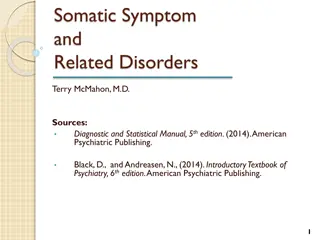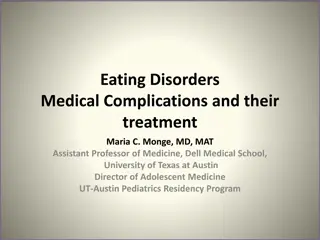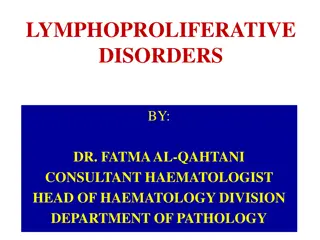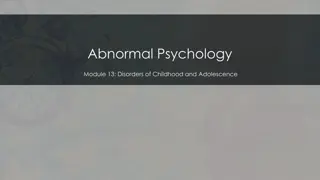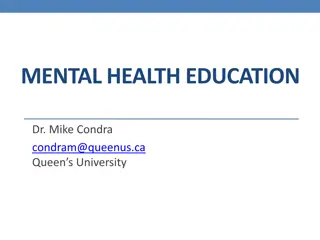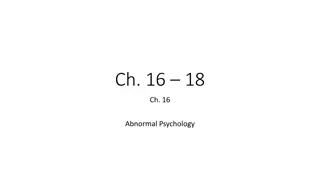Understanding Lymphoproliferative Disorders and Their Features
Explore the general features of lymphoproliferative disorders, including benign causes like infectious mononucleosis and the classification of malignant LPDs. Delve into chronic lymphoid leukemia, along with common LPDs such as Burkitt lymphoma, Follicular lymphoma, multiple myeloma, and Hodgkin lymphoma, focusing on clinicopathological features and differentiation from other conditions.
- Lymphoproliferative disorders
- Benign causes
- Malignant LPDs
- Chronic lymphoid leukemia
- Burkitt lymphoma
Download Presentation

Please find below an Image/Link to download the presentation.
The content on the website is provided AS IS for your information and personal use only. It may not be sold, licensed, or shared on other websites without obtaining consent from the author. Download presentation by click this link. If you encounter any issues during the download, it is possible that the publisher has removed the file from their server.
E N D
Presentation Transcript
Lymphoproliferative disorders Objectives: To understand the general features of lymphoproliferative disorders (LPD) To understand some benign causes of LPD such as infectious mononucleosis To understand the general classification of malignant LPD To understand the clinicopathological features of chronic lymphoid leukemia To understand the general features of the most common (LPD) (Burkitt lymphoma, Follicular lymphoma, multiple myeloma and Hodgkin lymphoma). Important. Extra. Notes Success is the result of perfection, hard work, learning from failure, loyalty, and persistence. Colin Powell References: 436 girls & boys slides 435 teamwork slides Editing file Do you have any suggestions? Please contact us! @haematology436 E-mail: Haematology436@gmail.com or simply use this form
Definitions Lymphoma (20min) Lymphoproliferative disorders: Several clinical conditions in which lymphocytesare produced in excessive quantities (Lymphocytosis) increase in lymphocytes that are not normal Lymphoma: Malignant lymphoid mass involving the lymphoid tissues. ( other tissues e.g: skin, GIT, CNS ..) The main deference between Lymphoma & Leukemia is that the Lymphoma proliferate primarily in Lymphoid Tissue and cause Mass , While Leukemia proliferate mainly in BM& Peripheral blood Lymphoid leukemia: Malignant proliferation of lymphoid cells in Bone marrow and peripheral blood. ( other tissues e.g: lymph nodes, spleen, skin, GIT, CNS ..) BCL is an anti-apoptotic (prevent apoptosis) Lymphocytosis (causes) 1- Viral infection: Infectious mononucleosis, cytomegalovirus, rubella, hepatitis, adenoviruses, varicella The most common cause of lymphocytosis is viral infection 2- Some* bacterial infection: (Pertussis, brucellosis) * Usually bacterial infections give PMN 5- Chronic lymphocytic leukemia (CLL) 6- Other lymphomas: Mantle cell lymphoma , Hodgkin lymphoma 3- Immune : SLE, Allergic drug reactions 4- Other conditions:, splenectomy, dermatitis, hyperthyroidism metastatic carcinoma) Mature lymphocyte Smear cell NO blasts! Reactive lymphocyte Infectious mononucleosis (May predispose the patient to Lymphoma if it chronic) An acute, infectious disease, caused by Epstein-Barr virus(EBV) characterized by: - Fever - Swollen lymph nodes (painful) lymphadenopathy - Sore throat - Atypical lymphocyte http://bioweb.uwlax.edu/bio203/s2009/weisser_mich/tonsils.JPG Affect young people (usually) most common cause of lymphocytosis in children Clinically, IM presents like ALL. But when we do blood smear we will find atypical lymphocytes and NO blasts and this will rule out ALL.
In a hurry? Skip to the table (slide 7) \ \ Malignant lymphoproliferative disorders - CLL - Hairy cell leukemia - T- prolymphocytic leukemia - Leukemic phase of lymphoma This lecture is about B-Lymphocytes Only! - Burkitt lymphoma - Diffuse large B lymphoma - Follicular lymphoma - Multiple myeloma Immature (ALL) Malignant Lymphoproliferative disease Lymphoid Leukemia Mature Hodgkin Lymphoma B- Cell 90% Non-Hodgkin T- Cell 10% B cell is more common but has better prognosis. You have to know which are T-cell or B-cell -Adult T leukemia lymphoma - Sezary syndrome* - Large anaplastic T lymphoma Journey of B-lymphocytes & mutations that cause disorders:- Leave bone marrow and are mature In bone marrow * T This circle is lymph node Germinal center Mantle zone Key: Disorder Mutation Na ve surface Ig) ) MD IgM & IgD) ) Cell type Markers Throughout the maturation where ever the disease occurs (at which stage) there will be specific findings For the mutations notice that they all have the number 14 so just memorise the other number.
Chronic lymphocytic leukemia - Malignant neoplasm characterized by an increased number of small, mature lymphocytesin the blood (>5,000 ) and bone marrow ( spleen and lymph node) - The most common adult leukemia (~25% of adult leukemias) - The median age is ~55 to 65 years. ( rare < 40 years). - 1.5 to 2 times more common in men than women. Features: - 40% of patients are asymptomatic at diagnosis. - Moderate lymphadenopathy and splenomegaly - Lymphocytosis (>5,000): (Most important) - Small mature-appearing lymphocytes - Condensed ( soccer ball ) nuclear chromatin - Numerous smudge cells - Predisposition to infection - Autoimmune phenomena (autoimmune hemolytic anemia) - Transformation to large cell lymphoma (Richter s syndrome) CLL Staging Soccer ball smudge cells
Burkitts Lymphoma High-grade non-Hodgkin's B-cell lymphoma which is rapidly growing (fastest growing tumor in humans) and highly aggressive with extremely short doubling time (24 hrs) but it has excellent response if we act quickly (see the picture) Types:- 1-Endemic: associated with chronic malaria and EBV In equatorial Africa . It particularly affects the jaw, other facial bone and breast. 2-Sporadic: occurs throughout the world and affects GIT. 3-Immunodeficiency-associated: associated with HIV infection or the use of immunosuppressive drugs. Morphology Genetics Biopsy BMA Burkitt lymphoma, touch prep, Wright stain.jpg http://www.pathpedia.com/education/eatlas/histopathology/lymph_node/burkitt_lymphoma/burkitt-lymphoma-%5b1-ln071-1%5d.jpeg?Width=600Height=450Format=4 Homogenous medium size cells with round nuclei and deeply basophilic and vacuolatedcytoplasm Highly associated witht(8;14) Translocation of the c-MYC proto-oncogene at chromosome 8 to immunoglobulin gene at chromosome 14 The c-MYC is nuclear transcription factor . Diffuse infiltration with "starry sky (Macrophages engulfing the apoptotic cells) Follicular Lymphoma - A malignant proliferation of germinal center B cells centrocyte which has at least a partially follicular pattern. - Due to overexpression o f Bcl2 (anti apoptotic gene become + ) caused by t(14;18) . - Most common type of indolent lymphoma (25% ). - Indolent but incurable (some exceptions) May take long time to present but when it does it is incurable ( Follicular Lymphoma Management Median survival is around 10 years. Transformation to aggressive lymphoma (DLBCL) can occur Immunophenotyping: Positive for CD10, CD20 and Bcl2 Negative for CD5 ( in most cases) ) Diagnosis Presented as: Lymphadenopathy (100%) splenomegaly (80%) BM involvement (60%) blood involvement (40%).
Multiple Myeloma Malignant B neoplasm characterized by a triad of abnormalities: 1. Accumulation of plasma cells in the bone marrow 2. Lytic Bone lesions (can cause bone Pain & Fracture) 3. Production of a monoclonal immunoglobulin (Ig) or Ig fragments Pathogenesis Accumulation Bone Lesions Monoclonal Ig production Fracture in bones Dark basophilic cytoplasm & nucleus is at the side Hodgkin Lymphoma Indolent (Idle) malignant lymphoma characterized by: 1- Presence of few large binucleated cells (Reed-Sternberg) RS cells surrounded by reactive cells (lymphocytes, plasma cells, eosinophils) 2- Involving cervical lymph nodes in young adults (most often) They become very huge! http://www.jpgathology.com/slides-13/slides/LymphNode_HodgkinsLymphoma_NS_ReedSternberg2.jpg Lymph node Involvement Reed-Sternberg Possible Pathogenisis Diagnosis CD 15 CD 30 Germinal center B cell with EBV leads to dinucleate(RS cell) which in response lead to loss of apoptosis (accumulation) & recruit cytokines These markers should be positive.
Summary Malignant Lymphoproliferative Disorders Mature Lymphoid leukemia Lymphoma Types Non Hodgkin lymphoma B- cell neoplasm CLL Hodgkin Multiple Myeloma Mantle Cell Burrkit s Follicular DLBCL CD20, CD138 CD56 CD5 CD19 CD20 CD19, CD20 CD23, CD5 CD19, CD20 CD10 CD15 CD30 Markers t(3;14) BCL-6 Centro- blasts t(8;14) C-myc GC blast t(14;18) BCL-2 Centrocytes Mature na ve B- cell IgM & IgD t(11;14) Cyklin D Plasma cells Mutations Diagnosis: Lymphocytosis (>5,000): Small mature- appearing lymphocytes Condensed ( soccer ball ) nuclear chromatin Numerous smudge cells rapidly growing and highly aggressive with extremely short doubling time (24 hrs) - a partially follicular pattern Malignant B neoplasm Indolent (Idle) malignant lymphoma characterized by a triad of abnormalities: Accumulatio n of plasma cells in the bone marrow Lytic Bone lesions Production of a monoclonal immunoglobu lin (Ig) or Ig fragments Presented as: Lympha- denopathy (100%) Spleno- megaly (80%) BM involve- ment (60%) Blood involve- ment (40%) characterized by: 1- Presence of few large binucleated cells (Reed- Sternberg) surrounded by reactive cells (lymphocytes, plasma cells, eosinophils) 2- Involving cervical lymph nodes in young adults (most often) Morphology: 1- BMA: Homogenous medium size cells with round nuclei and deeply basophilic and vacuolated cytoplasm 2- Biopsy: Diffuse infiltration with "starry sky (Macrophages engulfing the apoptotic cells) Features -Moderate lymphadenopathy and splenomegaly Most common adult leukemia Male > Female Types: 1-Endemic: associated with chronic malaria and EBV In equatorial Africa. affects the jaw, other facial bone and breast. 2-Sporadic: affects GIT. 3- Immunodeficiency -associated: associated with HIV infection or immunosuppressive drugs Most common type of indolent lymphoma, but incurable (some exceptions). Complications: Predisposition to infection Autoimmune phenomena (autoimmune hemolytic anemia) Transformatio n to large cell lymphoma (Richter s syndrome) Transformati on to aggressive lymphoma (DLBCL) can occur Notes Cure rate: 90% at early phase 70% at advance disease
MCQs: 1- Which of the following can cause Infectious Mononucleosis? a- Autoimmune diseases b- Malaria c- E.Coli d- Epstein-Barr Virus 2- Ahmad is 35-Years old went to his family physician suffering from severe pain in his bones, After investigations his physician advised him to see Hematologist, the Hematologist told Ahmad that he has type of B-cells lymphoma, What is the most likely diagnosis in Ahmad s condition? a- CLL b- Multiple myeloma c- Burkitt Lymphoma d-Hodgkin Lymphoma 3- Khaled 25-Years old come to you to make general check-up, in CBC you find that his Lymphocyte number is more than 5000 (normal=1500-2700), in blood film you found Soccer ball appearance & Smudge cells, what is most likely diagnosis in this case? a- CLL b- Multiple myeloma c- Burkitt Lymphoma d-Hodgkin Lymphoma 4- Which type of lymphoma is featured by presence of Binucleated cells (Reed- Sternberg) & involves cervical lymph nodes mainly? a- CLL b- Multiple myeloma c- Burkitt Lymphoma d-Hodgkin Lymphoma 5- t(8;14) C-MYC Mutation is associated with which one of the following? a- CLL b- Multiple myeloma c- Burkitt Lymphoma d-Hodgkin Lymphoma 5- c 4- d 3- a 2- b 1- d GOOD LUCK! Team members: Khalid Al-Eisa Abdulkarim Al-Harbi Jawaher Abanumy Team Leaders: Abdulaziz Al-Hussainy Safa Al-Osaimi






